Sparkle SP6600TI Review



Introduction
NVIDIA have had their new Ti range of cards out for a little while now. Cast your mind back to an October the 1st announcement by the graphics giant where the Titanium series of GPU's was announced. We now have to replace the entire GeForce2 and GeForce3 lineups a new lineup of cards carrying the Ti name. GeForce2 Ti, along with GeForce3 Ti200 and GeForce3 Ti500 comprise NVIDIA current consumer card lineup.
The GeForce2 is considered a 2nd tier card now, being a generation of GPU behind the current flagship NVIDIA GPU, the GeForce3. However for the discerning gamer on a budget or the canny upgraders they sit at a price point where you can't really get more power for the money.
It's a GeForce2 Ti powered card that Sparkle have given us in the form of the SP6600Ti. We've seen Sparkle cards before at Hexus and we recently reviewed their GeForce3 card, the SP7000.
Sparkles card follows the official NVIDIA specification pretty much to the letter. We have 64Mb of DDR memory running at 400Mhz, 250Mhz core speed and TV-out. As far as clocks go, the Ti sits between the old GeForce2 Pro (200/400) and GeForce2 Ultra (250/458) cards by stealing the memory clock from the Pro and the core clock from the Ultra.
Considering that ultimately the GeForce2 craves memory bandwidth over core clock, the card sits just above the Pro in terms of outright performance.
Specification
NVIDIA 2nd-Generation Transform and Lighting Engine
NVIDIA Shading Rasteriser
AGP4X with AGP Texturing and Fast Writes
Hardware Anti-Aliasing
32-bit Z/Stencil Buffer
Fully accelerates the WindowsXP multimedia and user interface
32-bit full colour rendering
NVIDIA Unified Drivers
128-bit DDR Memory Interface
1 Billion pixels per second rendering power
6.4Gb per second memory bandwidth
>31 million transformed and lit triangles per second
Clock Speeds: 250MHz Core, 400MHz Memory
350Mhz RAMDAC - supports resolutions up to 2048x1536x16bpp @ 75Hz (32bpp @ 60Hz)
AGP4X with Fast Writes
TV-Out
64Mb 128-bit DDR memory
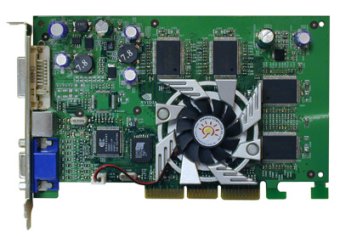
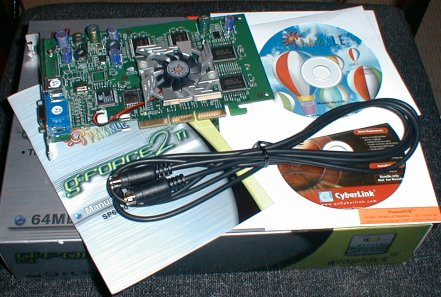
As you can see, the 6600Ti sticks faithfully to the reference design from NVIDIA with only their own heatsink arrangement and PCB colour being the real deviation. Notice that the card doesn't ship with ramsinks attached. I can't imagine them adding much more than a few dollars or pounds to the final cost and they would endear the card more to the overclocker. However when the price is a deciding factor as it is with GF2 Ti cards, every little matters.
Performance
Before we hit the numbers, lets take a peek at the test system used.
Test System:
- Shuttle AV40R VIA P4X266 Socket 478 Motherboard
- Intel 1.7GHz Pentium 4 Processor w/ Stock Intel Retail Cooler
- 256Mb Crucial PC2100 CAS2.5 (@CAS2) DDR
- Adaptec 39160 PCI SCSI Dual Channel U160 controller
- 2 x 73Gb Seagate Cheetah U160 10,000rpm SCSI disks
- Plextor 12/10/32S SCSI CDRW
- Creative 12x IDE DVD
Test Software:
- Windows XP Professional Build 2600.xpclient.010817-1148
- DetonatorXP 22.40 NVIDIA drivers
- Quake3 v1.30 (four.dm_66 demo)
- Unreal Tournament 436 (Thunder demo)
- Aquamark v2.36
- 3DMark 2001 Professional
Quake3 first from our list of 4 benchmarks. It's the lone OpenGL benchmark from the list of 4. It doesn't need any DX8 class features to run and should therefore run very well on the Sparkle. In the following graphs you can see performance at our three test resolutions of 1024x768, 1280x1024, 1600x1200

The performance degrades by over 50% as the resolution increases and the fillrate of the cards is stressed to the limit. At the highest resolution where the frame size is a hefty 1600x1200 the card is called on to do a lot of work processing pixel and vertex data and texture mapping using multiple passes per texture. Raw card speed shines through. Even at 1600x1200, 32bit colour and 32bit texture with everything on, framerate is very close to 60fps. Drop to the more common gaming resolution of 1024x768 and performance skyrockets to 120fps+ and is immensely playable. On our mid range test setup the 6600Ti is commendably fast.
Unreal Tournament Build 436 is our legacy DirectX application from the pre-DX8 days. It doesn't need DX8 class features and due to its age, GF2 users can testify to great performance on Unreal Tournament. Lets see if our testing keeps things moving.
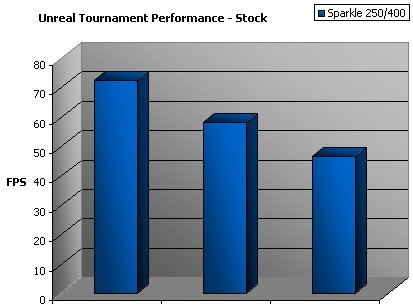
As the resolution increases from 1024x768 to 1280x1024 and finally on to 1600x1200 we can see the card fillrate having an effect on the scores however compared to the Quake3 results, the performance hit is a lot less severe and the starting fps is quite a bit lower than Quake3's. UT spends a lot of time processing world objects and actors therefore the rendering engine gets held back so to speak. Increasing CPU power has a bigger effect on UT scores than card clocks for the most part
Aquamark is a benchmarking application based on the cool games from Massive, Aquanox. It uses the Krass engine and is heavy on the use of DX8 features, especially pixel and vertex shaders. We run the default Aquanox bench here at Hexus. Just fire her up and run the bench, no tweaking of settings. The GeForce2 Ti wont fair as well as DX8 class hardware here. For simple reference, a GF3 Ti500 running on NVIDIA's nForce board scored 45.8fps.
AquaNox - AquaMark V2.3 2001/11/20 - (c) Massive Development ------------------------------------------------------------ RESOLUTION : 1024x768x32 FSAA : NONE PIXELSHADER: NO TEXTURE : 24MB SECONDS : 106.65 ..... MIN FPS : 11.4 MAX FPS : 38.7 AVG FPS : 21.2We're losing over 50% performance to the Ti500 nForce combination for a few reasons. The main reason being the reliance on DX8 features to run well. Given that the GF2 Ti doesn't do the pixel and vertex shader in hardware (remember, NVIDIA licensed the shader spec for DX8 to Microsoft after the GF2 was released) it's no surprise. 21.2 is below our acceptable performance level for gaming so a resolution drop would be needed to play Aquanox on this card on the test system at acceptable levels.
Finally 3DMark, our other DX8 benchmark. One of the first, if not THE first common application to rely on DX8 features for the best performance, 3DMark runs a serious of tests in sequence (or out of order if you are benching for big scores and know the tricks) and uses the results to calculate a final points score. A tweaked out GF2 machine with good hardware behind it gets into the 6000 point range for reference. 9000+ scores are doable with DX8 hardware and fast processors with 7000+ being a good target for DX8 class hardware.
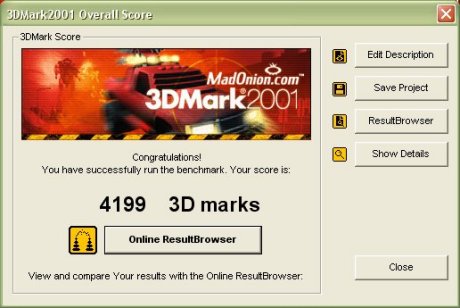
For a stock benchmark run, no tweaks of any kind, 1 point shy of 4200 is respectable. Bear in mind that for upper class scores in 3DMark on NVIDIA hardware you need to tweak the driver a lot from it's standard settings and lower the visual quality and 4200 is fine. The card cannot run the Nature test which is a big points winner for the right hardware so it's all relative.
So all in all stock out of the box performance is good. In the non DX8 specific benchmarks the card performs very well indeed. Quake3 and UT engined games will run superbly on this card at stock settings. It's only the newer DX8 feature specific games that trip the card up and even then, performance can be made acceptable meaning it's a fine card for someone needing a fast 3D accelerator but cant or wont buy something on the bleeding edge.
Overclocked Performance
After having seen some results from friends running the Gainward GF2 Ti, I had high hopes from overclocking the 6600Ti. 300+/500+ are common speeds for the Gainward it seems to I aimed for the same. I used the following method to determine the maximum stable clock speeds. Upping the clocks by 5Mhz each time, running a loop of High Detail Dragothic for 10 iterations, watching carefully for any visual anomalies and then increasing or decreasing the clocks depending on whether artifacting occurred.
High Detail Dragothic is the most strenuous test in 3DMark 2001 for NVIDIA hardware. If your clocks are too high, High Dragothic will usually catch you out. After the testing, the highest stable clock was 267/468. Quite a bit slower than some of the Gainward clocks I've seen and not that much higher than the stock core speed but an overclock worth of testing all the same. The increase in memory bandwidth will be useful for the notoriously hungry GF2 core.
Again, Quake3 first.
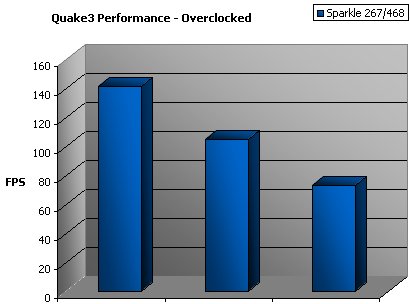
We gain roughly 10-15fps here depending on resolution with the high resolution tests gaining the most from the overclocking of the card. This is due to the fillrate of the card coming in to play at high resolutions whereas at lower resolutions, performance is more CPU bound as the card waits to be passed data. The converse happens as you increase the work the card has to do.
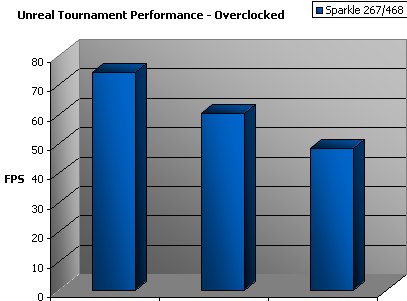
The performance increase from UT is minimal. As we explained before, UT is heavily CPU limited and card clocks tend to not have much effect. We are seeing that here to good effect. An increase is still an increase however and the scores certainly haven't gone down!
AquaNox - AquaMark V2.3 2001/11/20 - (c) Massive Development ------------------------------------------------------------ RESOLUTION : 1024x768x32 FSAA : NONE PIXELSHADER: NO TEXTURE : 24MB SECONDS : 105.16 ...... MIN FPS : 11.6 MAX FPS : 38.4 AVG FPS : 21.5With Aquamark we can see that our increase had little to no effect on the score. Maximum frames per second has actually dropped. We can theorise that on the GF2, Aquamark is CPU limited. However this is not due to the card waiting on the CPU for data because the low score proves that wrong. In this case, since the CPU is responsible for the effects rather than the card since the card doesn't do the DX8 effects Aquamark uses, increasing the CPU speed on the host system effectively, for Aquamark at least, increases the speed of the shader engine since it's done on CPU instead of on card.
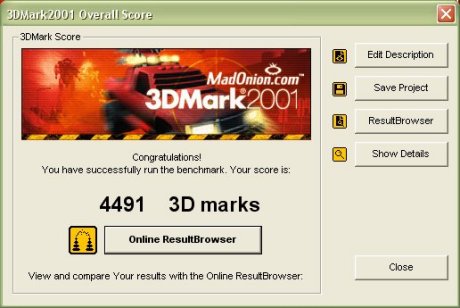
It's a different story with 3DMark. Here we see a 300 point increase for our efforts. 3DMark has traditionally responded well to card clocks on NVIDIA hardware. With 3DMark 2000, memory bandwidth and fillrate ruled the roost. There has been a swing in favour of the core clock increase in 3DMark 2001 and it's this which is mostly responsible for our increase here as the onchip functions such as the TnL engine get a boost in performance. You can see how the 300+ core Gainwards approach and surpass 6000 marks here with a good CPU behind them.
Overall, the gains in overclocking were to be made in Quake3 (and all the Q3 engine games) and 3DMark 2001. The other 2 were more CPU limited and overclocking had a minimal performance boost. All in all, it didn't hurt any of the benchmarks and overclocking NVIDIA cards is trivially easy with something like RivaTuner so you may as well give it a shot. Passively cooling the memory chips would help here although we can't officially recommend it since it voids your warranty! A decent performance from the Sparkle however certain Gainwards are going a lot faster for the same money.
Conclusion
I'm quite a fan of this little card from a price/performance standpoint. It's cheap and still has the rendering power to play 95% of your games with ease. TV-Out was a winner too. Nothing very special with only 800x600 maximum resolution but there is just something about playing some Max Payne or Q3: Urban Terror on the wide screen. TV-Out cable was included of course. The SP6600Ti is also backed up by a unique 1 year end user warranty and free web support.
The price for the SP6600Ti is around £115 and if you hunt, maybe you can find it cheaper. Sparkle's exposure in the UK isn't great so you'll have to hunt for this one. If you can find it then the performance for the price makes it a recommended buy. Well done Sparkle. My only criticism is the relatively poor overclocking, maybe something that they can rectify with future cards to appeal more to the overclocking crowd. Otherwise, very nice for the price.













